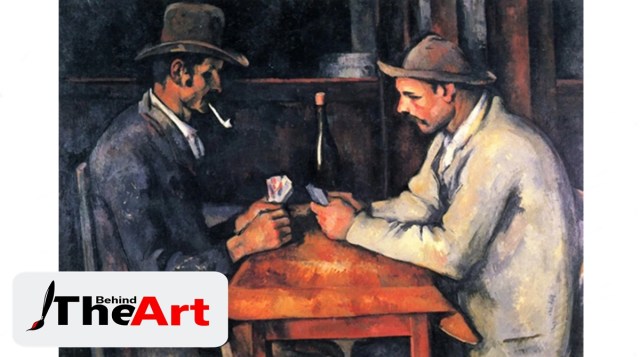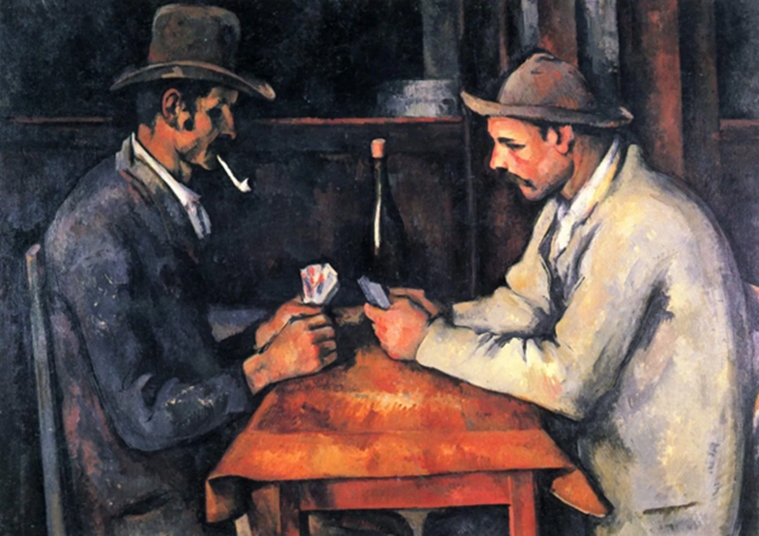📣 For more lifestyle news, click here to join our WhatsApp Channel and also follow us on Instagram
Behind the Art: What is the meaning of The Card Players by Paul Cézanne? Is it worth $250 million?
Oil-rich Qatar bought Paul Cézanne's painting "The Card Players" for more than $250 million in 2011 but is it worth it? And what importance does it hold?
 One of the most expensive and highly acclaimed paintings to ever be sold at an auction recently has been The Card Players which was painted by the French Post-Impressionist artist Paul Cézanne in the early 1890s. (Photo: paulcezanne.org)
One of the most expensive and highly acclaimed paintings to ever be sold at an auction recently has been The Card Players which was painted by the French Post-Impressionist artist Paul Cézanne in the early 1890s. (Photo: paulcezanne.org) The art world consists of several paintings that make a high place for themselves in the market. Be it the unusual techniques used by the artists or the fact that it will act as a social status symbol, auctions for paintings made in the 1800s continue to engage art lovers across the globe. One of the most expensive and highly acclaimed paintings to ever be sold at an auction recently has been The Card Players which was painted by the French Post-Impressionist artist Paul Cézanne in the early 1890s. Cézanne painted five paintings in the series which not only vary in size but also in the number of players and the setting in which the game takes place. Out of The Card Players series, one version was sold in 2011 to the Royal Family of Qatar for a price estimated at $250 million ($301.1 million today). The other four versions of the paintings are housed in world-class museums, including the Musée d’Orsay in Paris and the Metropolitan Museum of Art in New York. What does the painting signify and why is it so expensive?
Story Behind the Art
 The Card Players painting bought by Qatar for such a jaw-dropping price shows two men at the table playing cards. Cézanne was known to inspire Cubism and helped pioneer abstract art, and Picasso called him “the father of us all.” (Photo: paulcezanne.org)
The Card Players painting bought by Qatar for such a jaw-dropping price shows two men at the table playing cards. Cézanne was known to inspire Cubism and helped pioneer abstract art, and Picasso called him “the father of us all.” (Photo: paulcezanne.org)
The Card Players painting bought by Qatar for such a jaw-dropping price shows two men at the table playing cards. Cézanne was known to inspire Cubism and helped pioneer abstract art, and Picasso called him “the father of us all.” The series is considered by art critics to be a cornerstone of Cézanne’s art during the early-to-mid 1890s period and a prelude to his final years when he painted some of his most famous works. Visually, the painting is very simple to explain and comprehend. It depicts two peasants immersed in their pipes and playing cards. Both subjects are male and studious. Their eyes are cast downward and are focused on the game at hand. Unlike Picasso’s cubist paintings or Van Gogh’s impressionist ones where there is a lot to decode for the viewer, this one is relatively simple just like the times Cézanne was inspired by. Cézanne adapted a motif from 17th-century Dutch and French genre painting which often depicted card games with rowdy, drunken gamblers in taverns. He instead painted his subjects with stone-faced tradesmen in a more simplified setting. The Dutch and French genres showcased heightened moments of drama which Cézanne chose to avoid in his painting. They also showed drinks and money on the table, something which Cézanne chose to change and painted an unused wine bottle. Some art historians claim the painting represented Cézanne’s personal life and his strained relationship with his father and that the cards symbolise unspoken words between the two. During the early 1860s, Cézanne rejected the legal and banking careers advocated by his father and instead studied art, a profession his father considered grossly impractical. Cézanne however ended up being very popular in the art world and helped lay the foundations of the transition from the 19th-century conception of artistic work to a new and radically different world of art in the 20th century.
Why is it so expensive and talked about
After the auction which sold this painting for $250 million, many critics asked the question – is the painting worth it or is it known because a famous painter painted it? One critic described the painting as ‘human still life’ because of how calm the whole setting in the painting is. The models for the paintings were local farmhands, some of whom worked on the Cézanne family estate, the Jas de Bouffan. Each scene is depicted as one of peaceful, still concentration; the men look down at their cards rather than at each other, with the cards being conceivably their sole means of communication outside of work. Now, this is no epic Van Gogh landscape painting or a Vermeer portrait but Qatar invested millions of dollars in it. Some say by doing this Qatar won its entry into an exclusive art club. If one takes any art-history course, The Card Players is likely in it because it is a major painting. And now, thanks to the purchase, Qatar will forever be mentioned in history books across the globe. The price that the oil-flush kingdom chose to pay shows how it has asserted itself as a world-class intellectual mecca, courting top universities and financial institutions and muscling its way into cultural pertinence. That includes collecting gushing amounts of premium art both Western and Islamic. The crowning jewel of it all, The Card Players, was also in the news for robbery attempts. One of the versions now on exhibit in Paris was in the hands of daring burglars in August of 1961. It was the most famous of eight Cézanne paintings snatched from a travelling show in his hometown of Aix-en-Provence, France. It is not clear how the paintings were retrieved but according to sources, the paintings were returned a few months later once a ransom was paid, while others claim the whole lot was uncovered a year later in Marseille within an abandoned car. And to add to the dramatic whirlpool of events, to show the depths of the national sense of loss over Card Players’ theft, a memorial stamp was issued, creating a colourful tag for a grim event.
One would have to possibly take an art history course to truly understand what the painting shows and means, however, the circumstances and the name attached to The Card Players series make it worth talking about in the 21st century.
Next up in Behind the Art: What is the story behind Van Gogh’s Portrait of Joseph Roulin? Is it one of the most valuable paintings ever painted by Van Gogh?
📣 For more lifestyle news, follow us on Instagram | Twitter | Facebook and don’t miss out on the latest updates!
📣 For more lifestyle news, click here to join our WhatsApp Channel and also follow us on Instagram



- 01
- 02
- 03
- 04
- 05

























